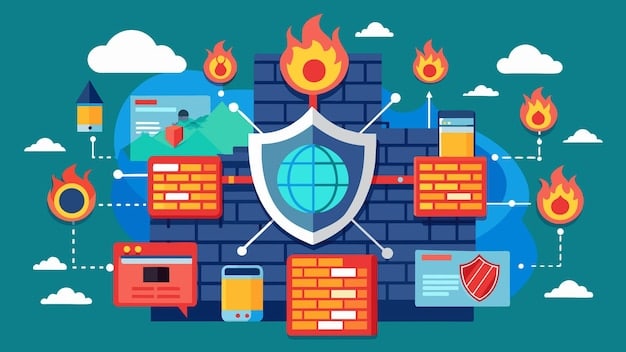New Cybersecurity Threat: Protect Your Small Business from Ransomware Attacks

Protecting your small business from ransomware attacks is crucial in today’s digital landscape; understanding the new cybersecurity threats and implementing robust measures can safeguard your business’s data and financial stability.
In today’s interconnected world, small businesses face ever-growing cybersecurity threats, with ransomware attacks being among the most prevalent and damaging. It’s crucial that you, as a business owner, understand the new cybersecurity threat: protect your small business from ransomware attacks, and adopt proactive measures to defend against these malicious actors.
Understanding the Ransomware Threat Landscape
The threat landscape for ransomware is constantly evolving, with attackers developing new techniques to bypass traditional security measures. Understanding the current state of these threats is crucial for building a strong defense.
The Rise of Ransomware-as-a-Service (RaaS)
One of the key trends is the rise of Ransomware-as-a-Service (RaaS), which allows even non-technical individuals to launch sophisticated ransomware attacks. This has significantly broadened the pool of potential attackers and increased the frequency of attacks.
Targeting Small Businesses
Small businesses are increasingly becoming prime targets for ransomware attacks. They often lack the robust security infrastructure and dedicated IT staff of larger organizations, making them easier to compromise. Attackers recognize this vulnerability and are actively exploiting it.

To further understand the ransomware threat, consider these key points:
- Initial Infection: Ransomware often gains entry through phishing emails, malicious websites, or software vulnerabilities.
- Data Encryption: Once inside the network, ransomware encrypts sensitive data, rendering it inaccessible.
- Ransom Demand: Attackers then demand a ransom payment in exchange for the decryption key.
- Exfiltration Threats: Some ransomware variants also exfiltrate data, threatening to release it publicly if the ransom is not paid.
In conclusion, the ransomware landscape is evolving rapidly, with RaaS and the targeting of small businesses being key trends. Understanding these threats is the first step in building a strong defense.
Assessing Your Small Business’s Vulnerabilities
Identifying and addressing vulnerabilities is a critical step in protecting your small business from ransomware attacks. This involves conducting a thorough assessment of your IT infrastructure and security practices.
Conducting a Risk Assessment
Begin by conducting a comprehensive risk assessment to identify potential weaknesses in your system. This includes evaluating your network infrastructure, software applications, employee training, and data backup and recovery procedures.
Identifying Weak Points
Pay close attention to areas where your business may be particularly vulnerable, such as outdated software, weak passwords, and lack of employee awareness. These are common entry points for ransomware attacks.
Here are several areas to consider during your vulnerability assessment:
- Software Updates: Ensure all software, including operating systems and applications, is up to date with the latest security patches.
- Password Management: Enforce strong password policies and encourage employees to use unique, complex passwords for all accounts.
- Employee Training: Conduct regular cybersecurity training to educate employees about phishing scams, social engineering tactics, and other common attack vectors.
- Firewall and Antivirus: Implement robust firewall and antivirus solutions and keep them updated.
In conclusion, assessing your small business’s vulnerabilities is a vital step. Conduct a thorough risk assessment, identify weak points, and implement measures to address these vulnerabilities effectively.
Implementing a Multi-Layered Security Approach
A multi-layered security approach is a strategic framework that combines multiple security controls to protect against a wide range of threats. By implementing several layers of defense, you can significantly reduce the risk of a successful ransomware attack.
Firewall and Network Security
Firewalls act as a barrier between your network and the outside world, controlling incoming and outgoing traffic. Configure your firewall to block unauthorized access and monitor network activity for suspicious patterns.
Endpoint Protection
Endpoint protection solutions, such as antivirus software and endpoint detection and response (EDR) tools, provide real-time protection against malware and other threats on individual devices. Ensure all devices, including desktops, laptops, and mobile devices, are protected.

Consider these additional layers of security to fortify your defenses:
- Intrusion Detection Systems (IDS): Monitor network traffic for malicious activity and alert security personnel to potential threats.
- Web Filtering: Block access to known malicious websites and prevent employees from downloading malicious content.
- Email Security: Implement email security solutions to filter out phishing emails and other email-borne threats.
In conclusion, a multi-layered security approach is essential for protecting your small business. By combining multiple security controls, you can significantly reduce the risk of a successful ransomware attack and protect your valuable data.
Educating Employees About Phishing and Social Engineering
Humans are often the weakest link in the security chain, making employee education a critical component of any cybersecurity strategy. Training employees to recognize and avoid phishing and social engineering attacks can significantly reduce the risk of a successful ransomware infection.
Recognizing Phishing Emails
Phishing emails are designed to trick recipients into revealing sensitive information or downloading malicious attachments. Teach employees to scrutinize emails for red flags, such as suspicious sender addresses, grammatical errors, and urgent requests for information.
Avoiding Social Engineering
Social engineering tactics involve manipulating individuals into performing actions that compromise security. Educate employees about common social engineering techniques, such as pretexting, baiting, and quid pro quo, and encourage them to be cautious when interacting with unfamiliar individuals or requests.
Here are some best practices for employee education:
- Regular Training: Conduct regular cybersecurity training sessions to reinforce best practices and introduce new threats.
- Simulated Phishing Attacks: Use simulated phishing attacks to test employees’ awareness and identify areas for improvement.
- Clear Policies: Establish clear policies regarding password management, data handling, and reporting suspicious activity.
In conclusion, educating employees about phishing and social engineering is vital. Regular training, simulated attacks, and clear policies can significantly reduce the risk of a successful ransomware infection.
Implementing Data Backup and Recovery Solutions
Data backup and recovery solutions are essential for mitigating the impact of a ransomware attack. By regularly backing up your data and having a robust recovery plan in place, you can minimize data loss and quickly restore your business operations.
Regular Data Backups
Establish a schedule for regular data backups, ensuring that all critical data is backed up on a consistent basis. Consider using a combination of on-site and off-site backups to protect against different types of disasters.
Testing Your Recovery Plan
Regularly test your data recovery plan to ensure that it is effective and that you can quickly restore your data in the event of a ransomware attack. This involves simulating a recovery scenario and verifying that all data can be restored correctly.
Consider these key elements when creating your data backup and recovery plan:
- Backup Frequency: Determine the appropriate backup frequency based on your business’s data change rate and recovery time objectives (RTOs).
- Backup Storage: Choose a secure and reliable backup storage solution, such as cloud storage or off-site data centers.
- Recovery Procedures: Document detailed recovery procedures to guide your IT staff through the restoration process.
In conclusion, implementing data backup and recovery solutions is indispensable. Regular backups and a robust recovery plan can minimize data loss and enable you to rapidly restore business operations following a ransomware attack.
Developing an Incident Response Plan
An incident response plan is a documented set of procedures for responding to and recovering from a cybersecurity incident, such as a ransomware attack. Having a well-defined plan in place can help you minimize downtime, contain the damage, and restore operations efficiently.
Identifying Key Stakeholders
Identify the key stakeholders who will be involved in the incident response process, including IT staff, management, legal counsel, and public relations personnel. Clearly define their roles and responsibilities.
Steps to Take During an Attack
Outline the specific steps to take during a ransomware attack, such as isolating infected systems, notifying law enforcement, and communicating with customers and stakeholders. Ensure that these steps are well-understood and can be executed quickly.
Your incident response plan should include these crucial components:
- Detection: Mechanisms for detecting ransomware infections, such as security alerts and monitoring systems.
- Containment: Procedures for isolating infected systems to prevent the spread of ransomware.
- Eradication: Steps for removing ransomware from infected systems and restoring data from backups.
In conclusion, developing an incident response plan is a proactive measure. A well-defined plan enables your business to respond quickly and effectively to ransomware attacks, thereby minimizing downtime and mitigating damage.
| Key Point | Brief Description |
|---|---|
| ⚠️ Vulnerability Assessment | Identify weak points to strengthen defenses. |
| 🛡️ Multi-Layered Security | Combine multiple security controls for robust protection. |
| 👨🏫 Employee Training | Educate staff to recognize and avoid phishing scams. |
| 💾 Data Backup | Regularly back up data for quick recovery. |
FAQ
▼
Ransomware is malicious software that encrypts your data, making it inaccessible until a ransom is paid. For small businesses, this can lead to significant downtime, financial losses, and reputational damage.
▼
Look for red flags such as suspicious sender addresses, grammatical errors, urgent requests for information, and links that don’t match the purported destination. Always be cautious when opening attachments or clicking links.
▼
A multi-layered security approach involves implementing multiple security controls, such as firewalls, antivirus software, and intrusion detection systems, to protect against a wide range of threats and minimize the impact of attacks.
▼
The backup frequency depends on your business’s data change rate and recovery time objectives. Critical data should be backed up daily or even more frequently to minimize data loss in the event of a ransomware attack.
▼
An incident response plan should include key stakeholders’ roles, detection mechanisms, containment procedures, eradication steps, and communication strategies to effectively respond to and recover from cybersecurity incidents.
Conclusion
In conclusion, protecting your small business from ransomware attacks requires a proactive and multi-faceted approach. By understanding the threat landscape, assessing vulnerabilities, implementing multi-layered security, educating employees, implementing data backup solutions, and developing an incident response plan, you can significantly reduce the risk of a successful ransomware attack and safeguard your business from the devastating consequences.





